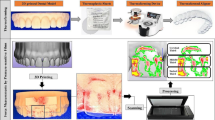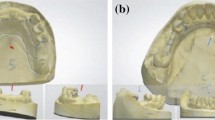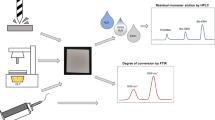Abstract
In orthodontic treatment with fixed appliances, the use of nickel alloy for archwire may cause nickel allergy suffered from the release of nickel ions. In addition, esthetic concerns are a problem for many people. Shape memory polymer (SMP), as a functional material with the ability of thermo-driven shape change to produce force and with good biocompatible properties, possesses the potential to be used in orthodontic appliances. To investigate the feasibility of using polyurethane (PU) as orthodontic archwire, a kind of SMP, namely shape memory polyurethane (SMPU), a simulation via finite element method was conducted, based on a new three dimensional (3D) thermo-mechanical constitutive model and data acquired from some mechanics experiments related to temperature. Finally, a tooth-moving simulation with SMPU archwire on a wax model was performed. The results illustrated that SMPU wire shows good prospects in orthodontic application: the archwire with a 0.5 mm diameter can supply recovery force with magnitude 0.588–1.176 N (60–120 g), which is within the required range 0.49–2.94 N (50–300 g) for tooth movement. However, the force is smaller than that produced from metal wire, and more work related to material strengthening, such as filling SMPU with reinforcement material, is required in the future.






Similar content being viewed by others
References
Bos, A., Hoogstraten, J., & Prahl-Andersen, B. (2003). Expectations of treatment and satisfaction with dentofacial appearance in orthodontic patients. American Journal of Orthodontics and Dentofacial Orthopedics, 123, 127–132.
Natali, A. N. (2003). Dental biomechanics. London: Taylor & Francis.
Zhang, H., Guo, S., Wang, D., Zhou, T., Wang, L., & Ma, J. (2016). Effects of nanostructured, diamondlike, carbon coating and nitrocarburizing on the frictional properties and biocompatibility of orthodontic stainless steel wires. Angle Orthodontist. doi:10.2319/090715-602.1.
Čolić, M., Tomić, S., Rudolf, R., Marković, E., & Šćepan, I. (2016). Differences in cytocompatibility, dynamics of the oxide layers’ formation, and nickel release between superelastic and thermo-activated nickel–titanium archwires. Journal of Materials Science Materials in Medicine, 27, 128.
Obaisi, N. A., Galang-Boquiren, M. T. S., Evans, C. A., Tsay, T. G. P., Viana, G., Berzins, D., et al. (2016). Comparison of the transformation temperatures of heat-activated Nickel-Titanium orthodontic archwires by two different techniques. Dental Materials, 32, 879–888.
Gil, F. J., & Planell, J. A. (1999). Effect of copper addition on the superelastic behavior of Ni-Ti shape memory alloys for orthodontic applications. Journal of Biomedical Materials Research, 48, 682–688.
Pompei-Reynolds, R. C., & Kanavakis, G. (2014). Interlot variations of transition temperature range and force delivery in copper-nickel-titanium orthodontic wires. American Journal of Orthodontics and Dentofacial Orthopedics, 146, 215–226.
Elahinia, M. H., Hashemi, M., Tabesh, M., & Bhaduri, S. B. (2012). Manufacturing and processing of NiTi implants: A review. Progress in Materials Science, 57(5), 911–946.
Liu, J. K., Lee, T. M., & Liu, I. H. (2011). Effect of loading force on the dissolution behavior and surface properties of nickel-titanium orthodontic archwires in artificial saliva. American Journal of Orthodontics and Dentofacial Orthopedics, 140, 166–176.
Martín-Cameán, A., Jos, Á., Mellado-García, P., Iglesias-Linaresc, A., Solanoa, E., & Cameánb, A. M. (2015). In vitro and in vivo evidence of the cytotoxic and genotoxic effects of metal ions released by orthodontic appliances: a review. Environmental Toxicology and Pharmacology, 40, 86–113.
Ghosh, P., & Srinivasa, A. R. (2011). A two-network thermomechanical model of a shape memory polymer. International Journal of Engineering Science, 49, 823–838.
Freitas, M. P. M., Oshima, H. M. S., & Menezes, L. M. (2011). Release of toxic ions from silver solder used in orthodontics: An in situ evaluation. American Journal of Orthodontics and Dentofacial Orthopedics, 140, 177–181.
Hussain, H. D., Ajith, S. D., & Goel, P. (2016). Nickel release from stainless steel and nickel titanium archwires: An in vitro study. Journal of Oral Biology and Craniofacial Research.. doi:10.1016/j.jobcr.2016.06.001.
Larrea, M., Zamora, N., Cibrian, R., Gandia, J. L., & Paredes, V. (2015). Pain evaluation between stainless steel and nickel titanium arches in orthodontic treatment: A comparative study. Chapter in emerging trends in oral health sciences and dentistry. Berlin: InTech.
Flanagan, J. (2015). Comparison of the mechanical and surface properties of retrieved and unused aesthetic orthodontic archwire, Dissetation for Master Degree, the University of Birmingham.
Rongo, R., Valletta, R., Bucci, R., Rivieccio, V., Galeotti, A., Michelotti, A., et al. (2016). In vitro biocompatibility of nickel-titanium esthetic orthodontic archwires. Angle Orthodontist. doi:10.2319/100415-663.1.
Singh, D. P. (2016). Esthetic archwires in orthodontics: A review. Journal of Oral Hygiene Health., 4, 194.
Nakasima, A., Hu, J. R., Ichinose, M., & Shimada, H. (1991). Potential application of shape memory plastic as elastic material in clinical orthodontics. European Journal of Orthodontics, 13, 179–186.
Liu, C., Qin, H., & Mather, P. T. (2007). Review of progress in shape-memory polymers. Journal of Materials Chemistry, 17, 1543–1558.
Wu, J., Yuan, C., Ding, Z., Isakov, M., Mao, Y., Wang, T., et al. (2016). Multi-shape active composites by 3D printing of digital shape memory polymers. Science Report, 6, 24224.
Lendlein, A., Behl, M., Hiebl, B., & Wischke, C. (2010). Shape-memory polymers as a technology platforms for biomedical applications. Expert Review of Medical Devices, 7(3), 357–379.
Singhal, P., Rodriguez, J. N., Small, W., Eagleston, S., Water, J. V., Maitland, D. J., et al. (2012). Ultra low density and highly crosslinked biocompatible shape memory polyurethane foams. Journal of Polymer Science Part B, 50, 724–737.
Lacerda-Santos, R., Nascimento, A. S. B., Pereira, A. R. B., Freire, P. P. M., Pithon, M. M., & Romanos, M. T. V. (2015). Citotoxicity of nonlatex elastomeric ligatures of orthodontic use. Revista Matéria, 20, 1–7.
Tobushi, H., Hara, H., Yamada, E., & Hayashi, S. (1996). Thermomechanical properties in a thin film of shape memory polymer of polyurethane series. Smart Materials and Structures, 5, 483–491.
Espinar, E., Llamas, J. M., Michiardi, A., Ginebra, M. P., & Gil, F. J. (2011). Reduction of Ni release and improvement of the friction behaviour of NiTi orthodontic archwires by oxidation treatments. Journal of Material Science, 22, 1119–1125.
Smith, S. L., Romanyk, D. L., Major, P. W., Paul, W., & Ayranci, C. (2016). An investigation on the preparation and mechanical properties of three-dimensional braided composite orthodontic archwires. Journal of International Oral Health, 8, 554–559.
Spendlove, J., Berzins, D. W., Pruszynski, J. E., & Ballard, R. W. (2015). Investigation of force decay in aesthetic, fibre-reinforced composite orthodontic archwires. European Journal of Orthodontics, 37, 43–48.
Tanimoto, Y., Inami, T., Yamaguchi, M., Nishiyama, N., & Kasai, K. (2015). Preparation, mechanical, and in vitro properties of glass fiber-reinforced polycarbonate composites for orthodontic application. Journal of Biomedical Materials Research, 103, 743–750.
Tobushi, H., Hashimoto, T., Hayashi, S., & Yamada, E. (1997). Thermomechanical constitutive modelling in shape memory polymer of polyurethane series. Journal of Intelligent Material Systems and Structures, 8, 711–718.
Tobushi, H., Okumura, H. K., Hayashi, S., & Itoj, N. (2001). Thermomechanical constitutive model of shape memory polymer. Mechanics of Materials, 33, 545–554.
Taherzadeh, M., Baghani, M., Baniassadi, M., Abriniaa, K., & Safdarib, M. (2016). Modeling and homogenization of shape memory polymer nanocomposites. Composites Part B, 91, 36–43.
Park, H., Harrison, P., Guo, Z., Lee, M. G., & Yu, W. R. (2016). Three-dimensional constitutive model for shape memory polymers using multiplicative decomposition of the deformation gradient and shape memory strains. Mechanics of Materials, 93, 43–62.
Djeu, G., Shelton, C., & Maganzini, A. (2005). Outcome assessment of Invisalign and traditional orthodontic treatment compared with the American Board of Orthodontics objective grading system. American Journal of Orthodontics and Dentofacial Orthopedics, 128, 292–298.
Han, J. Y. (2015). A comparative study of combined periodontal and orthodontic treatment with fixed appliances and clear aligners in patients with periodontitis. Journal of Periodontal & Implant Science, 45, 193–204.
Ata-Ali, F., Ata-Ali, J., Ferrer-Molina, M., Cobo, T., Carlos, F. D., & Cobo, J. (2016). Adverse effects of lingual and buccal orthodontic techniques: A systematic review and meta-analysis. American Journal of Orthodontics and Dentofacial Orthopedics, 149, 820–829.
Ni, Q. Q., Zhang, C., Fu, Y., Dai, G., & Kimura, T. (2007). Shape memory effect and mechanical properties of carbon nanotube/shape memory polymer nanocomposites. Composite Structures, 81, 176–184.
Yu, J. H., Wu, L. C., Hsu, J. T., Chang, Y. Y., Huang, H. H., & Huang, H. L. (2011). Surface roughness and topography of four commonly used types of orthodontic archwire. Journal of Medical and Biological Engineering, 31, 367–370.
Yang, B., Huang, W. M., Li, C., Lee, C. M., & Li, L. (2004). On the effects of moisture in a polyurethane shape memory polymer. Smart Materials and Structures, 13, 191–195.
Acknowledgements
This project is supported by National Natural Science Foundation of China (Grant No. 51375453), and the Scientific Research Foundation for the Returned Overseas Chinese Scholars, State Education Ministry.
Author information
Authors and Affiliations
Corresponding author
Rights and permissions
About this article
Cite this article
Liu, YF., Wu, JL., Zhang, JX. et al. Feasible Evaluation of the Thermo-mechanical Properties of Shape Memory Polyurethane for Orthodontic Archwire. J. Med. Biol. Eng. 37, 666–674 (2017). https://doi.org/10.1007/s40846-017-0263-z
Received:
Accepted:
Published:
Issue Date:
DOI: https://doi.org/10.1007/s40846-017-0263-z




